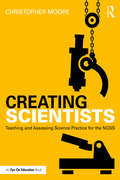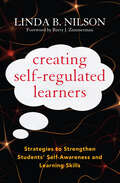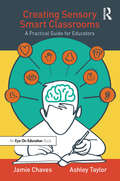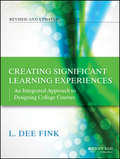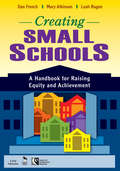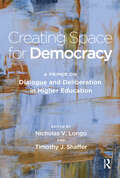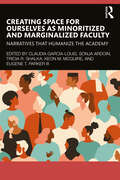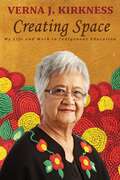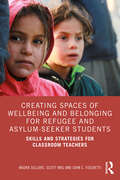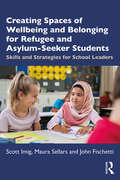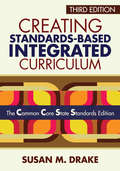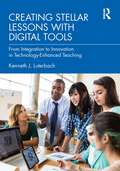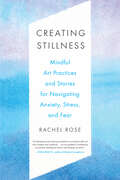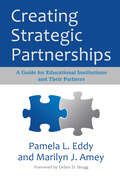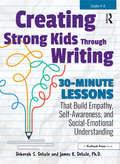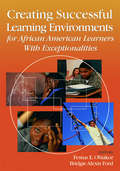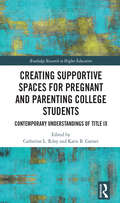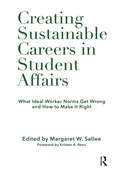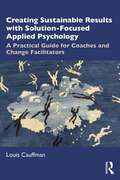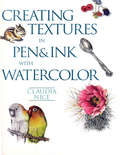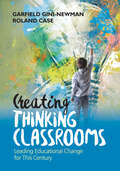- Table View
- List View
Creating Scientists: Teaching and Assessing Science Practice for the NGSS
by Christopher MooreLearn how to shift from teaching science content to teaching a more hands-on, inquiry-based approach, as required by the new Next Generation Science Standards. This practical book provides a clear, research verified framework for building lessons that teach scientific process and practice abilities, such as gathering and making sense of data, constructing explanations, designing experiments, and communicating information. Creating Scientists features reproducible, immediately deployable tools and handouts that you can use in the classroom to assess your students’ learning within the domains for the NGSS or any standards framework with focus on the integration of science practice with content. This book is an invaluable resource for educators seeking to build a "community of practice," where students discover ideas through well-taught, hands-on, authentic science experiences that foster an innate love for learning how the world works.
Creating Self-Regulated Learners: Strategies to Strengthen Students’ Self-Awareness and Learning Skills
by Linda B. NilsonMost of our students neither know how learning works nor what they have to do to ensure it, to the detriment both of their studies and their development as lifelong learners.The point of departure for this book is the literature on self-regulated learning that tells us that deep, lasting, independent learning requires learners to bring into play a range of cognitive skills, affective attitudes, and even physical activities – about which most students are wholly unaware; and that self-regulation, which has little to do with measured intelligence, can be developed by just about anyone and is a fundamental prerequisite of academic success.Linda Nilson provides the theoretical background to student self-regulation,the evidence that it enhances achievement, and the strategies to help students develop it. She presents an array of tested activities and assignments through which students can progressively reflect on, monitor and improve their learning skills; describes how they can be integrated with different course components and on various schedules; and elucidates how to intentionally and seamlessly incorporate them into course design to effectively meet disciplinary and student development objectives. Recognizing that most faculty are unfamiliar with these strategies, she also recommends how to prepare for introducing them into the classroom and adding more as instructors become more confident using them.The book concludes with descriptions of courses from different fields to offer models and ideas for implementation. At a time of so much concern about what our students are learning in college and how well prepared they are for the challenges of tomorrow’s economy and society, self-regulated learning provides a reassuring solution, particularly as studies indicate that struggling students benefit the most from practicing it.
Creating Sensory Smart Classrooms: A Practical Guide for Educators
by Ashley Taylor Jamie ChavesCreating Sensory Smart Classrooms introduces educators to the foundations of sensory processing and offers tools to meet the wide variety of sensory needs in each classroom. This comprehensive handbook helps readers understand the neurobiology behind sensory processing and regulation issues, recognize when a student is over- or under-stimulated, and integrate different sensory inputs into the school environment. Practical and accessible chapters foster an understanding of how sensory processing influences behaviors in the classroom and how protective relationships, combined with sensory strategies, positively influence students' regulation for improved learning outcomes. Packed with useful examples, this is essential reading for teachers looking to develop the knowledge and skills they need to design sensory smart environments that support ALL learners.
Creating Significant Learning Experiences
by L. Dee FinkIn this thoroughly updated edition of L. Dee Fink's bestselling classic, he discusses new research on how people learn, active learning, and the effectiveness of his popular model; adds more examples from online teaching; and further focuses on the impact of student engagement on student learning. The book explores the changes in higher education nationally and internationally since the publication of the previous edition, includes additional procedures for integrating one's course, and adds strategies for dealing with student resistance to innovative teaching. This edition continues to provide conceptual and procedural tools that are invaluable for all teachers when designing instruction. It shows how to use a taxonomy of significant learning and systematically combine the best research-based practices for learning-centered teaching with a teaching strategy in a way that results in powerful learning experiences for students. Acquiring a deeper understanding of the design process will empower teachers to creatively design courses that will result in significant learning for students.
Creating Small Schools: A Handbook for Raising Equity and Achievement
by Mary Atkinson Leah Rugen Dan FrenchOffers school leaders lessons, case studies, practical tools, advice, vignettes, and step-by-step instructions for developing new schools or converting existing ones, plus guidance for forging partnerships with the community.
Creating Space for Democracy: A Primer on Dialogue and Deliberation in Higher Education
by Nicholas V. Longo, Timothy J. ShafferPublished in Association with and We live in divisive and polarizing times, often remaining in comfortable social bubbles and experiencing few genuine interactions with people who are different or with whom we disagree. Stepping out and turning to one another is difficult but necessary. For our democracy to thrive at a time when we face wicked problems that involve tough trade-offs it is vital that all citizens participate fully in the process. We need to learn to listen, think, and act with others to solve public problems. This collaborative task begins with creating space for democracy. This book provides a guide for doing so on campus through deliberation and dialogue.At the most basic level, this book describes collaborative and relational work to engage with others and co-create meaning. Specifically, dialogue and deliberation are processes in which a diverse group of people moves toward making a collective decision on a difficult public issue.This primer offers a blueprint for achieving the civic mission of higher education by incorporating dialogue and deliberation into learning at colleges and universities. It opens by providing a conceptual framework, with leading voices in the dialogue and deliberation field providing insights on issues pertinent to college campuses, from free speech and academic freedom to neutrality and the role of deliberation in civic engagement. Subsequent sections describe a diverse range of methods and approaches used by several organizations that pioneered and sustained deliberative practices; outline some of the many ways in which educators and institutions are using dialogue and deliberation in curricular, co-curricular, and community spaces, including venues such as student centers, academic libraries, and residence halls. All of the chapters, including a Resource Section, provide readers with a starting point for conceptualizing and implementing their own deliberation and dialogue initiatives.This book, intended for all educators who are concerned about democracy, imparts the power and impact of public talk, offers the insights and experiences of leading practitioners, and provides the grounding to adopt or adapt the models in their own settings to create educative spaces and experiences that are humanizing, authentic, and productive. It is an important resource for campus leaders, student affairs practitioners, librarians, and centers of institutional diversity, community engagement, teaching excellence and service-learning, as well as faculty, particularly those in the fields of communication studies, education, and political science.Click here for more information on AAC&U and Campus Compact.
Creating Space for Ourselves as Minoritized and Marginalized Faculty: Narratives that Humanize the Academy
by Sonja Ardoin Tricia R. Shalka Eugene T. Parker Claudia García-Louis Keon M. McGuireCreating Space for Ourselves as Minoritized and Marginalized Faculty moves away from conventional faculty success books by providing early career faculty with innovative perspectives about successfully navigating the professoriate, while humanizing their lived experiences and naming the unspoken. Through the use of interdisciplinary methods, such as creative artistic expression, testimonios, and personal narratives, chapter authors share experiences learned about surviving, thriving, navigating, and succeeding as early career underrepresented and marginalized faculty. Chapters discuss issues such as navigating workplace hostility, finding community beyond the academy, work–life balance, and crafting a scholarly identity, while also offering little-known tips about how to survive the professoriate while growing into thriving minoritized and underrepresented scholars. This book explores personal and institutional factors that are seldom discussed in other career success books, helping faculty as well as institutional leaders understand how we can, individually and collectively, create systems that invite and recognize humanity while ensuring successful career pathways for marginalized folks with doctoral degrees.
Creating Space: My Life and Work in Indigenous Education
by Verna J. KirknessVerna J. Kirkness grew up on the Fisher River Indian reserve in Manitoba. Her childhood dream to be a teacher set her on a lifelong journey in education as a teacher, counsellor, consultant, and professor. Her simple quest to teach "in a Native way" revolutionized Canadian education policy and practice. Kirkness broke new ground at every turn. As the first cross-cultural consultant for the Manitoba Department of Education Curriculum Branch she made Cree and Ojibway the languages of instruction in several Manitoba schools. In the early 1970s she became the first Education Director for the Manitoba Indian Brotherhood (now the Assembly of Manitoba Chiefs) and then Education Director for the National Indian Brotherhood (now the Assembly of First Nations). She played a pivotal role in developing the education sections of Wahbung: Our Tomorrows, which transformed Manitoba education, and the landmark 1972 national policy of Indian Control of Indian Education. These two major works have shaped First Nations education in Canada for more than 40 years. In the 1980s she became an assistant professor at the University of British Columbia where she was appointed Director of the Native Teacher Education Program, founded the Ts’‘Kel Graduate Program, and was a driving force behind the creation of the First Nations House of Learning. Honoured by community and country, Kirkness is a visionary who has inspired, and been inspired by, generations of students. Like a long conversation between friends, Creating Space reveals the challenges and misgivings, the burning questions, the successes and failures that have shaped the life of this extraordinary woman and the history of Aboriginal education in Canada.
Creating Spaces of Wellbeing and Belonging for Refugee and Asylum-Seeker Students: Skills and Strategies for Classroom Teachers
by Maura Sellars Scott Imig John C. FischettiCreating Spaces of Wellbeing and Belonging for Refugee and Asylum-Seeker Students: Skills and Strategies for Classroom Teachers outlines the ways educators can support positive educational and social outcomes for the most vulnerable children in their communities. Each chapter briefly outlines the relevant theory, expanding on this through vignettes from research and analytical reflection, helping the reader identify and apply the differentiated pedagogical understandings in their own classrooms. Providing insights from educators who are doing this work successfully across the globe, the book highlights the challenges and considerations that teachers face in multilingual, multicultural classroom environments where students’ common experience is trauma and loss and guides them towards effective practice. This book is intended for use in schools by school leaders and classroom teachers and by educational professionals engaged in supporting schools with students with refugee backgrounds.
Creating Spaces of Wellbeing and Belonging for Refugee and Asylum-Seeker Students: Skills and Strategies for School Leaders
by Maura Sellars Scott Imig John FischettiThis practical resource for principals and school leaders provides guidance on how to develop schools into places of belonging for all children, especially children of refugee and asylum-seeker backgrounds. It demonstrates the need for school leaders to be informed, reflective individuals and highlights the role that leaders can play in a school culture that provides a safe place and effective educational opportunities for these students. Written in an accessible manner, each chapter includes a summary of theory and vignettes from school leaders that outline approaches, challenges, critical reflections and suggestions for how their experiences can be adapted to other contexts. Principals' voices and experiences from across the globe are included, representing a range of school levels including primary and secondary, large and small enrolments, religious and public, and urban and rural settings. This book is intended for use in schools by school principals and aspiring school leaders, and by educational professionals engaged in supporting schools with students with refugee backgrounds.
Creating Standards-Based Integrated Curriculum: The Common Core State Standards Edition
by Susan M. DrakeTranslate the new standards into meaningful curriculum! This updated edition of Susan Drake’s classic text serves as a road map through the Common Core State Standards, giving you the flexibility to design an integrated curriculum that’s right for your students. Focusing on multidisciplinary, interdisciplinary, and transdisciplinary approaches, Drake provides guidance on: <p><p> - Unpacking the Common Core State Standards <p> - Planning assessment tasks <p> - Designing instructional strategies <p> - Developing daily activities <p> - Helping students connect essential questions to enduring understandings <p> Included are new examples of exemplary programs, discussion questions, a sample completed interdisciplinary curriculum, and activities for building your own standards-based integrated curriculum.
Creating Stellar Lessons with Digital Tools: From Integration to Innovation in Technology-Enhanced Teaching
by Kenneth J. LuterbachCreating Stellar Lessons with Digital Tools prepares teachers in training and in-service teachers to use technologies for design and development activities with middle and high school students. While software, open resources, handheld devices, and other tools hold great potential to enhance learning experiences, teachers themselves must model technology use in ways that inspire students to become producers and leaders rather than consumers and followers. Featuring concrete applications in social studies, English, mathematics, and science scenarios, this book provides pre-service teachers with seven paths to creatively integrate and innovate with computational thinking, datasets, maker spaces, visual design, media editing, and other approaches.
Creating Stillness: Mindful Art Practices and Stories for Navigating Anxiety, Stress, and Fear
by Rachel RoseDiscover the healing power of expressive arts with this hands-on guide to using creative mindfulness to reduce stress, find presence, and unlock self-knowledge Expressive arts educator Rachel Rose weaves together mindfulness practice and art therapy to demonstrate how tapping into your own innate creativity can help you find peace in a stressful worldThis self-directed guide teaches ten key principles of mindfulness through ten creative invitations, along with a series of simple exercises and guided prompts to help you start noticing and flexing your creative mindfulness muscles: Anchoring your practice with ritual Setting intentions Honoring your impulses Trusting the process Non-striving Letting goRequiring no prior experience of the arts or mindfulness meditation, Creating Stillness provides tools to explore difficult emotions and find insight into personal struggles and traumatic wounds.In each chapter, Rose draws from her personal experience as a teacher and facilitator of creative mindfulness to share stories and examples that help ground exercises like sketching, creative writing prompts, and more.Rose carefully walks through the process each time, explaining how to set intention and arrive in the present moment before embarking on your mindful art session; how to use objects and thoughts as creative prompts; how to return your attention to your work as you move forward; and how to distill the wisdom you have found in the process. For seasoned artists, creative mindfulness offers a chance to slow down and rediscover the transformative power that art can offer when it is detached from the need to produce something beautiful or useful. For those coming to expressive arts with existing mindfulness practices or engaged in a therapeutic process, a mindful arts practice may reveal a passion for creation you didn&’t know existed. And for everyone, creative mindfulness can help us make sense of our feelings and find new ways of expressing ourselves--in art and in life.
Creating Strategic Partnerships: A Guide for Educational Institutions and Their Partners
by Pamela L. Eddy Marilyn J. AmeyWhat are the characteristics and conditions that lead to successful educational partnerships?What can we learn from partnerships that fail, cannot be sustained over time, or cease to benefit their partners?This book serves as a guide to the successful implementation of partnerships. It provides the context and tools for readers who are responding to the increasing demands of policy makers, funders and institutional leaders to use partnerships to address local, state and federal issues, achieve external mandates, meet public or internal agendas, or pursue international collaborations. This guide provides an evidence-based framework for institutional and organizational leaders to develop the vision, shared values and norms to achieve the “partnership capital” that will sustain an enduring relationship. It offers a three-phase model of the development process of collaboration, together with a tool box for those charged with partnering and leading organizational change, and includes a template for both creating new partnerships and sustaining existing ones.The authors start by differentiating between “traditional,” often ad-hoc, partnerships and “strategic partnerships” that align organizational strategy with partnership actions; and by identifying the importance of moving beyond incremental or surface “first order” change to develop deep “second order change” through which underlying structures and operations are questioned and new processes emerge due to the partnership. They offer analyses and understandings of seven key components for success: exploring motivations; developing partner relationships; communicating and framing purpose; creating collaborative structures and resources; leading various partnership stages; generating partnership capital; and implementing strategies for sustaining partnerships. Each chapter concludes with a case study to provide more understanding of the ideas presented, and for use in training or classes. This guide is addressed to policy makers and educational leaders, college administrators, and their non-profit and business partners, to enable them to lead and create strategic partnerships and facilitate organizational change.
Creating Strategic Readers: Techniques for Developing Competency in Phonemic Awareness, Phonics, Fluency, Vocabulary, and Comprehension
by Valerie ElleryHere Author Valerie Ellery describes a comprehensive literacy classroom, detailing appropriate curriculum, assessment, and instruction. The book includes numerous exciting and engaging techniques geared to students' reading levels and incorporating students' multiple intelligences. This updated, revised, and expanded second edition features: Over 140 classroom-tested techniques 35 new techniques. An expanded focus on educating the whole child A motivation/engagement section for many techniques. An accompanying CD with a wide assortment of reproducibles and assessment forms.
Creating Strong Kids Through Writing: 30-Minute Lessons That Build Empathy, Self-Awareness, and Social-Emotional Understanding in Grades 4-8
by James Delisle Deborah S. DelisleTeachers are always looking for activities that not only enhance the mechanics of writing—grammar, spelling, and syntax—but also allow students to express themselves in creative and personal ways. Creating Strong Kids Through Writing is the perfect resource for teachers seeking quick, ready-to-use writing lessons that encourage social and emotional growth, personal development, introspection, and innovative thinking in students. Each of the 20 lessons has been classroom-tested with students of all ability levels in grades 4-8, and each lesson contains one or more samples of student work to help guide and inspire student writers. Creating Strong Kids Through Writing is a resource teachers will turn to again and again when they seek writing lessons that, although short in duration, are lasting in their personal impact on student growth.Grades 4-8
Creating Successful Learning Environments for African American Learners With Exceptionalities
by Dr Festus E. Obiakor Dr Bridgie Alexis FordIn this groundbreaking book, more than 25 leading scholars and practitioners provide concrete solutions for maximizing African American students' achievement.
Creating Supportive Spaces for Pregnant and Parenting College Students: Contemporary Understandings of Title IX (Routledge Research in Higher Education)
by Catherine L. Riley Katie B. GarnerThis volume brings together interdisciplinary research, theoretical perspectives, and detailed explanations of paths and examples to help colleges become supportive spaces for pregnant and parenting students. Expanding the discourse around pregnant and parenting college students to a more interdisciplinary and international arena, this volume follows the ground-breaking disquisition, formerly set forth by ‘Title IX and the Protection of Pregnant and Parenting College Students (Riley, Hutchinson, Dix 2022)’, to define this cohesive field and bring together separate voices to help colleges become more supportive spaces after the . The chapters explore academia’s attitude toward motherhood, families, and care work, the invisibility of pregnant and parenting students, system-wide negligence, the forgotten nature of student-fathers, unacknowledged miscarriages, organized policy change efforts, involved agencies of change, the troubling presence of coercion, and more. While arguing that barriers currently prevent colleges from becoming supportive spaces, the volume asserts that improvements are both feasible and vital for ensuring that institutions of higher education are complying with Title IX, a U.S. federal law. Offering interdisciplinary research, explanations of problems, and paths for progress, this edited volume will be useful to scholars, researchers, administrators, and activists working to support pregnant and parenting students. Various chapters will also interest those working in higher education administration, education policy, reproductive health, gender studies, and health and organizational communication more broadly. Supporting pregnant and parenting college students, however, is a shared responsibility belonging to all members of a campus community; accordingly, this volume is for every institution that plans to comply with Title IX.
Creating Sustainable Careers in Student Affairs: What Ideal Worker Norms Get Wrong and How to Make It Right
by Margaret W. Sallee, Kristen A. RennThis book argues that the current structure of student affairs work is not sustainable, as it depends on the notion that employees are available to work non-stop without any outside responsibilities, that is, the Ideal Worker Norm. The field places inordinate burdens on staff to respond to the needs of students, often at the expense of their own families and well-being. Student affairs professionals can meet the needs of their students without being overworked. The problem, however, is that ideal worker norms pervade higher education and student affairs work, thus providing little incentive for institutions to change. The authors in this book use ideal worker norms in conjunction with other theories to interrogate the impact on student affairs staff across functional areas, institutional types, career stage, and identity groups. The book is divided into three sections; chapters in the first section of the book examine various facets of the structure of work in student affairs, including the impact of institutional type and different functional areas on employees’ work-lives. Chapters in the second section examine the personal toll that working in student affairs can take, including emotional labor’s impact on well-being. The final section of the book narrows the focus to explore how different identity groups, including mothers, fathers, and people of color, navigate work/life issues. Challenging ideal worker norms, all chapters offer implications for practice for both individuals and institutions.
Creating Sustainable Results with Solution-Focused Applied Psychology: A Practical Guide for Coaches and Change Facilitators
by Louis CauffmanThis practical, evidence-based guide details how professional practitioners and change facilitators can integrate a solution-focused approach into their daily work and practice. While conventional therapeutic methods centre on the assumption that problems arise due to deficiencies, and therefore focus on diagnosis and subsequent treatment, the solution-focused approach is resource-based and operates on the assumption that human beings always have resources at their disposal to move forward. Free from the burden of detailed problem analysis, the solution-focused approach prioritizes clients’ hope for change in their lives and taps into the opportunities and resources available to bring about such transformation. The solution-focused practitioner is able to design incisive interventions that are flexible enough to adapt to any situation clients might find themselves in, and this book provides a practical formulation that is immediately applicable to all professional fields of applied psychology. Creating Sustainable Results with Solution-Focused Applied Psychology is important reading for therapists and coaches of all schools of thought, as well as anyone who practices as a professional change facilitator, including social workers, mediators, business leaders, and educators.
Creating Textured Landscapes with Pen, Ink and Watercolor
by Claudia NiceCapture the Rich Textures of Nature, Step by StepCapture nature's beauty as you never have before. Beloved artist and teacher Claudia Nice leads you on an inspired journey through the great outdoors. With paints in hand, she shares with you her best techniques for creating landscapes that come alive with richness, depth and textured detail. Open this guide and start painting right away. As you follow engaging, step-by-step demonstrations and exercises, you'll learn to recreate the textural elements of a range of terrains and landscapes. Chapters include:Creative clouds and skies Majestic mountains, hills and mesas Texturing trees, trunks and foliageRugged rocks and gritty gravel Transparent textures for rivers, falls and lakes Flowers of the field In a special section, Claudia covers basic texturing techniques with mini demos using lines, dots, bruising, scribbling, spattering, blotting, printing, stamping and more. From paints and pens to sponges, leaves and facial tissue, you'll explore all kinds of fun and inventive ways to create amazing textures. And to help you put it all together, Claudia includes her masterful advice for creating compositions using reference photos, field sketches and your own creative license. Each demonstration features a large image of the completed landscape, so you can see exactly how Claudia's methods work - from start to finish.
Creating Textures in Pen & Ink with Watercolor
by Claudia NiceClaudia Nice shows you how to turn ink and watercolors into the coarse-barked trunk of an oak, or the burnished smoothness of brass, or the verdant velvet of moss. Or any of many other things. She shows you how to use dots, fine lines, brushstrokes, black and white, color-a mixture of mediums and techniques-to suggest:glass cast iron adobe and brick sunrise and sunset driftwood leaf textures basketry surf and ocean waves enamelware rainbows wood grain distant trees eggs and onions animal hair and dozens of other textures! You'll learn how to use materials, from technical pens to paint brushes, colored inks to liquid acrylics. You'll discover ways to blot, spatter, stamp and otherwise alter and combine ink and watercolor for exciting texturing effects.
Creating Textures in Watercolor: A Guide to Painting 83 Textures from Grass to Glass to Tree Bark to Fur
by Cathy JohnsonSilken strands of hair. Water tumbling over rocks. Blinding reflections in glass or metal.Cathy Johnson shows you how to create realistic textures like these and make your watercolor paintings come alive.You'll find practical, easy-to-follow guidelines inside for creating 83 wonderful textures for fruits, vegetables, hair, glass, metal, fabric, flowers, fur, skin and much, much more.Johnson's beautiful watercolor sketches - complete with helpful captions - demonstrate each of these techniques and their many variations. You'll learn how to accurately recreate any texture you see and create lovely watercolor paintings that almost seem to breathe.Cathy Johnson's expertise will show you how to expand your own artistic vision and discover a world of textures - a world you can capture with your brush.
Creating Thinking Classrooms: Leading Educational Change for This Century
by Garfield Gini-Newman Roland CaseReinvigorating today’s schools with Critical, Creative and Collaborative thinking Critical, creative and collaborative thinking should be at the centre of all 21st century teaching and learning. Creating Thinking Classrooms is loaded with examples, stories and strategies for reinvigorating schools with this quality thinking. Written for leaders who support teachers, this guide treats educational change as a process of renovation, rather than process of revolution, and emphasizes building upon, refining and sustaining the many good things happening in today’s schools. Practical and user-friendly, it emphasizes five key principles for learning and teaching: Engaging students Sustaining inquiry Nurturing self-regulated learners Creating assessment-rich learning Enhancing learning through digital technology As a balanced and reasoned response to the challenges and opportunities facing schools, this book separates the rhetoric of school reform from reality by analyzing what’s actually happening and offering a plan educators can use. Recapture the fundamentals of classroom learning with a practical and powerful roadmap charting the way forward. As a principal and community superintendent, I observed firsthand how transformational the work of Garfield Gini-Newman and Roland Case is in the school community, and on a systemic level, in the school community, and on a systemic level. Creating Thinking Classrooms takes theory and research and places it directly into the hands of practitioners by offering thoughtful and immediately-useful strategies. Not only does this work transform engagement and achievement, but it also transforms thinking for both teachers and their students. Teaching and learning go from passive acquisition of information to active, purposeful, and deliberate interaction with the curriculum. It is a must-read! Ursula A. Hermann, Ph.D, retired principal and community superintendent Montgomery County Public Schools What impresses me most about Creating Thinking Classrooms is the notion of framing the retooling of schools as renovation or reinvigoration rather than as revolution. Too many seem to ignore that there are many good things worth preserving in our schools and others that need to be reframed or recast to give them greater currency. This book builds on what has worked and makes it better. The message – being purposeful and patiently focused on long-term success – is a powerful one that needs to be heard above the din. David Chojnacki, Executive Director Near East South Asia Council of Overseas Schools
Creating Thinking Classrooms: Leading Educational Change for This Century
by Garfield Gini-Newman Roland CaseReinvigorating today’s schools with Critical, Creative and Collaborative thinking Critical, creative and collaborative thinking should be at the centre of all 21st century teaching and learning. Creating Thinking Classrooms is loaded with examples, stories and strategies for reinvigorating schools with this quality thinking. Written for leaders who support teachers, this guide treats educational change as a process of renovation, rather than process of revolution, and emphasizes building upon, refining and sustaining the many good things happening in today’s schools. Practical and user-friendly, it emphasizes five key principles for learning and teaching: Engaging students Sustaining inquiry Nurturing self-regulated learners Creating assessment-rich learning Enhancing learning through digital technology As a balanced and reasoned response to the challenges and opportunities facing schools, this book separates the rhetoric of school reform from reality by analyzing what’s actually happening and offering a plan educators can use. Recapture the fundamentals of classroom learning with a practical and powerful roadmap charting the way forward. As a principal and community superintendent, I observed firsthand how transformational the work of Garfield Gini-Newman and Roland Case is in the school community, and on a systemic level, in the school community, and on a systemic level. Creating Thinking Classrooms takes theory and research and places it directly into the hands of practitioners by offering thoughtful and immediately-useful strategies. Not only does this work transform engagement and achievement, but it also transforms thinking for both teachers and their students. Teaching and learning go from passive acquisition of information to active, purposeful, and deliberate interaction with the curriculum. It is a must-read! Ursula A. Hermann, Ph.D, retired principal and community superintendent Montgomery County Public Schools What impresses me most about Creating Thinking Classrooms is the notion of framing the retooling of schools as renovation or reinvigoration rather than as revolution. Too many seem to ignore that there are many good things worth preserving in our schools and others that need to be reframed or recast to give them greater currency. This book builds on what has worked and makes it better. The message – being purposeful and patiently focused on long-term success – is a powerful one that needs to be heard above the din. David Chojnacki, Executive Director Near East South Asia Council of Overseas Schools
